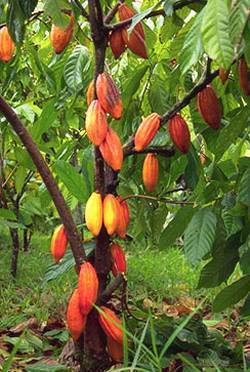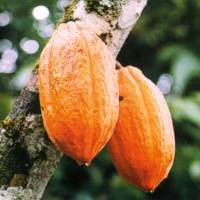 |
Cocoa beans are the product of the cacao tree. The origin of the cacao tree is in dispute. Some say it originated in the Amazon basin of Brazil, others place it in the Orinoco Valley of Venezuela, while still others contend that it is native to Central America.
Wherever its first home, we know the cacoa tree is strictly a tropical plant thriving only in hot, rainy climates.
The cacao tree is very delicate and sensitive. It needs protection from the wind by other, taller trees and requires shade. A newly planted cacao seedling is often sheltered by a different type of tree. It is normal to plant food crops for shade such as banana, plantain, coconuts or cocoyams. Rubber trees and forest trees are also used for shade. Once established, however, cacao trees can grow in full sun light, provided there are fertile soil conditions and intensive husbandry. Cacao plantations, usually in valleys or coastal plains, must have evenly distributed rainfall and rich, well drained soil.
As a general rule, cacao trees get their start in a nursery bed where seeds from high yielding trees are planted in fiber baskets or plastic bags. The seedlings grow so fast that in a few months they are ready for transplanting. With pruning and careful cultivation, the trees of most strains will begin bearing fruit in the fifth year.
Everything about the tree is as colorful as its history. An evergreen, the cacao tree has large glossy leaves that are red when young and green when mature. Overlays of clinging moss and colorful lichens are often found on the bark of the trunk, and in some areas beautiful small orchids grow on its branches. The tree sprouts thousands of tiny waxy pink or white five-pedaled blossoms that cluster together on the trunk and older branches. But, only three to 10 percent will go on to mature into full fruit.
 |
| Ripe cacao pods almost ready to be harvested |
The fruit, which will eventually be converted into chocolate, has green, yellow or maroon colored pods on the trunk of the tree and its main branches.
At its maturity, the cultivated tree measures from 15 to 25 feet tall, though the tree in its wild state may reach 60 feet or more.
The potential age of a tree is open to speculation. There are individual trees known to be over 200 years of age, but no one has determined the real life span of the species. However, in 25 years the economic usefulness of a tree may be considered at an end, and it often becomes desirable to replant with younger trees.
While the cacao tree bears fruit (or pods) all year round, harvesting is generally seasonal. The pods come in a variety of types since cacao trees cross-pollinate freely. These types can be reduced to three classifications: Criollo, the prince of cacaos, is a soft thin-skinned pod, with a light color and a unique, pleasant aroma. Forastero, a more plentiful type, is easier to cultivate and has a thick-walled pod and a pungent aroma. Trinitario, which is believed to be a natural cross from strains of the other two types, has a great variety of characteristics but generally possesses good, aromatic flavor; and these trees are particularly suitable for cultivation.
In the Western Hemisphere plantations composed of one species of cocoa trees are uncommon. Even single trees with all the characteristics of a specific type are rare. Uniformity exists only where cacao plantations have been developed from the rooted branch cuttings of single mother trees.
 |
| Fully ripe cacao pods |
In recent years cacao growers have turned increasingly to hybridization as a means of improving the quality of the bean and making it more disease resistant. Scientists using state-of-the-art biotechnology techniques are also trying to improve the quality of cacao and its resistance to disease.
The job of picking ripe cacao pods is not an easy one. The tree is so frail and its roots are so shallow that workmen cannot risk injuring it by climbing to reach the pods on the higher branches.
The planter sends his tumbadores, or pickers, into the fields with long handled, mitten-shaped steel knives that can reach the highest pods and snip them without wounding the soft bark of the tree. Machetes are used for the pods growing within reach on the lower trunk.
It requires training and experience to know by appearance which fruit is ripe and ready to be cut. Ripe pods are found on trees at all times since the growing season in the tropics, with its evenly distributed rainfall, is continuous.
For most localities there is a main harvest lasting several months and a mid-crop harvest lasting several more months. Climatic differences cause wide variations in harvest times with frequent fluctuations from year to year even within the same location.
(Source: www.karachocolates.com)
|



